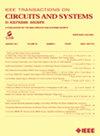A Visual-Cortex-Mimetic Tiny Neuromorphic Vision Processor Based on Reconfigurable Cortical Neuron Unit
IF 4.9
2区 工程技术
Q2 ENGINEERING, ELECTRICAL & ELECTRONIC
IEEE Transactions on Circuits and Systems II: Express Briefs
Pub Date : 2025-03-19
DOI:10.1109/TCSII.2025.3571598
引用次数: 0
Abstract
Edge visual systems demand high energy-efficiency vision processors like neuromorphic hardware leveraging spike-based computations. But their disability of directly interacting with non-spike information in the real world requests additional components to execute image pre-processing, spike encoding and decoding, severely increasing overall system cost, energy and latency. To overcome such drawback, this brief proposes a tiny neuromorphic vision processor which emulates functional regions along the ventral pathway in the visual cortex. It performs image pre-processing, spike encoding, spike-based feature extraction and classification, spike decoding as well as decision making on a single chip. To reduce hardware resources, our processor builds on a reconfigurable cortical neuron (RCN) unit, which runs different neuron models for different visual cortex regions in a time-multiplexing fashion. It also embeds biological learning circuits to better adapt the processor to dynamic edge scenarios. Our neuromorphic processor was prototyped on a very-low-cost Xilinx Zynq-7010 device. On the MNIST dataset, it exhibited a real-time inference speed of 696 frame/s covering image pre-processing to final decision and a high on-chip learning accuracy of 97.12%, while only delivering a power consumption as low as 118 mW.基于可重构皮质神经元单元的仿视觉皮质微型神经形态视觉处理器
边缘视觉系统需要高能效的视觉处理器,比如利用基于峰值计算的神经形态硬件。但是它们不能直接与现实世界中的非尖峰信息交互,需要额外的组件来执行图像预处理、尖峰编码和解码,严重增加了整个系统的成本、能量和延迟。为了克服这一缺陷,本文提出了一种微小的神经形态视觉处理器,它模拟了视觉皮层中沿腹侧通路的功能区域。它在单个芯片上完成图像预处理、尖峰编码、基于尖峰的特征提取和分类、尖峰解码以及决策。为了减少硬件资源,我们的处理器建立在一个可重构皮层神经元(RCN)单元上,该单元以时间复用的方式为不同的视觉皮层区域运行不同的神经元模型。它还嵌入了生物学习电路,以更好地使处理器适应动态边缘场景。我们的神经形态处理器的原型是在一个非常低成本的Xilinx Zynq-7010设备上。在MNIST数据集上,它展示了696帧/秒的实时推理速度,涵盖图像预处理到最终决策,片上学习精度高达97.12%,而功耗仅为118 mW。
本文章由计算机程序翻译,如有差异,请以英文原文为准。
求助全文
约1分钟内获得全文
求助全文
来源期刊
CiteScore
7.90
自引率
20.50%
发文量
883
审稿时长
3.0 months
期刊介绍:
TCAS II publishes brief papers in the field specified by the theory, analysis, design, and practical implementations of circuits, and the application of circuit techniques to systems and to signal processing. Included is the whole spectrum from basic scientific theory to industrial applications. The field of interest covered includes:
Circuits: Analog, Digital and Mixed Signal Circuits and Systems
Nonlinear Circuits and Systems, Integrated Sensors, MEMS and Systems on Chip, Nanoscale Circuits and Systems, Optoelectronic
Circuits and Systems, Power Electronics and Systems
Software for Analog-and-Logic Circuits and Systems
Control aspects of Circuits and Systems.

 求助内容:
求助内容: 应助结果提醒方式:
应助结果提醒方式:


